Archived Article Detail
By Thomas P. Moore
WHAT’S NEW IN THE MINERAL WORLD ARCHIVE – posted on 1/12/2007
As I begin to draft this installment of “What’s New in the Mineral World” it is early January, holiday decorations have come down all over, and “Tucson fever” (I feel safe in guessing) is starting to visit plenty of folks, including some reading this now. Surely a month from now I’ll know vastly more than I do today about interesting new minerals hitting the international market; indeed I’ll be starting to write the Tucson Show report which will run, as usual, in our May-June issue. But maybe this account of a few things spotted online since the time of the Munich Show will provide readers something to dream on while they are packing their liquids and creams into baggies such as will not be confiscated along the skyways leading to Tucson.
Web News
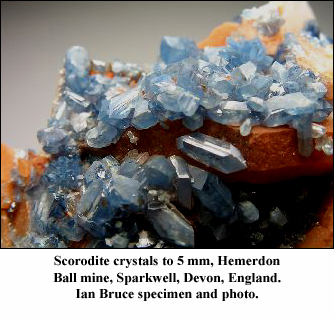 Between January and August of 2000, a specimen-hunting effort at the remains of the old Hemerdon Ball mine, Sparkwell, Devon, England, yielded about 2,000 specimens showing fine scorodite crystals in vugs in a hard, lightly iron-stained quartzite, with microcrystals of a few other very rare phosphate species. Too bad that the individual scorodite crystals only reach 5 mm at their very largest, as they are sharp, lustrous, translucent to transparent, and bright blue to deep bluish green depending on incident light (the “alexandrite effect”). After very brief appearances on the market, these specimens had pretty much disappeared by late 2001—but, to quote from the website of the English dealership Broadstone Minerals (www.broadstoneminerals.com), “Recent excavation work over the summer [of 2006] has produced another exciting batch…exceptionally rich and colorful scorodite specimens, large cassiterite crystals and pharmacosiderite combinations were found.” This work has been sponsored by Ian’s Bruce’s dealership Crystal Classics (www.crystalclassics.co.uk), and on that website you can see some pictures of the Hemerdon Ball mine, with a brief account of its geology and mineralogy and of the recent collecting efforts. Attractive specimens now available on both English websites mentioned above show gemmy blue scorodite crystals to 5 mm, some as isolates, most composing druses and sprays, on matrix pieces of various sizes.
Between January and August of 2000, a specimen-hunting effort at the remains of the old Hemerdon Ball mine, Sparkwell, Devon, England, yielded about 2,000 specimens showing fine scorodite crystals in vugs in a hard, lightly iron-stained quartzite, with microcrystals of a few other very rare phosphate species. Too bad that the individual scorodite crystals only reach 5 mm at their very largest, as they are sharp, lustrous, translucent to transparent, and bright blue to deep bluish green depending on incident light (the “alexandrite effect”). After very brief appearances on the market, these specimens had pretty much disappeared by late 2001—but, to quote from the website of the English dealership Broadstone Minerals (www.broadstoneminerals.com), “Recent excavation work over the summer [of 2006] has produced another exciting batch…exceptionally rich and colorful scorodite specimens, large cassiterite crystals and pharmacosiderite combinations were found.” This work has been sponsored by Ian’s Bruce’s dealership Crystal Classics (www.crystalclassics.co.uk), and on that website you can see some pictures of the Hemerdon Ball mine, with a brief account of its geology and mineralogy and of the recent collecting efforts. Attractive specimens now available on both English websites mentioned above show gemmy blue scorodite crystals to 5 mm, some as isolates, most composing druses and sprays, on matrix pieces of various sizes.
Speaking of English minerals, the (Japanese) dealership called Key’s Minerals, after proprietor Kiyoshi Kiikuni, is offering fine pieces from the English fluorite collection of Jesse Fisher (of California—ah, the internationalism of mineral collecting!). Outstanding and “classic”-looking fluorite clusters from august old localities like the Rotherhope Fell mine, Alston Moor, Cumbria; the Ladywash mine, Eyam, Derbyshire; the Hilton mine, Scordale, Cumbria; and the Frazer’s Hush mine, Weardale, Durham, all may be seen, together with a small but choice selection of worldwide, including Japanese, minerals, on Kiyoshi’s website (www.keysminerals.com).
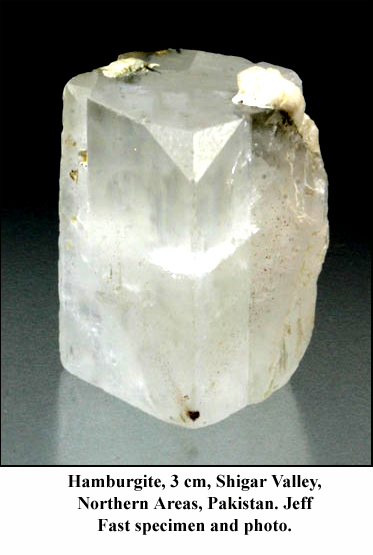 A likable site which I’ve been meaning to mention for some time now is that of JBF Minerals (jbfminerals.com), run by Jeff Fast of East Haddam, Connecticut. Among its features is a section called “My Finds,” wherein Jeff shows pictures of fine specimens he has dug from pegmatites in Connecticut (sometimes, in the days when I dug on these same rockpiles, I would run into Jeff—although my own finds could never compete with such excellent crystals of, for example, ferrocolumbite from the Swanson and Hollister quarries as are pictured here). There is also a “Your Finds” section, displaying treasures dug by Jeff’s friends in places from Connecticut to Virginia to Elba—and then come the specimen offerings, which are from worldwide sources although heavy on Mexico, Pakistan and Afghanistan. Jeff goes to Mexico often, and he is promising that he’ll soon have “new silver specimens” from that country. In the December 3 update, the most impressive piece from Asia (to my taste) is a loose, doubly terminated and twinned, super-sharp crystal of hambergite from the Shigar Valley, Northern Areas, Pakistan, measuring 2 × 2 × 3 cm. And on New Year’s Day Jeff posted a lovely array of grossular specimens from two occurrences, the majority of these pieces having been sold by January 5. First, there are a few smallish thumbnails showing exquisite dodecahedral gemmy green grossular crystals to 4 mm on matrix, from the Jeffrey mine, Quebec; second, there are several miniature and cabinet-size matrix specimens studded with lustrous, gemmy orange grossular crystals, individually to 1 cm, from Vesper Peak, Snohomish County, Washington. It is a curious fact that Vesper Peak grossular crystals are the only known garnets which commonly display cube faces, and, sure enough, in the JBF specimens you can see small faces of the cube form cutting off points of the luscious orange dodecahedrons.
A likable site which I’ve been meaning to mention for some time now is that of JBF Minerals (jbfminerals.com), run by Jeff Fast of East Haddam, Connecticut. Among its features is a section called “My Finds,” wherein Jeff shows pictures of fine specimens he has dug from pegmatites in Connecticut (sometimes, in the days when I dug on these same rockpiles, I would run into Jeff—although my own finds could never compete with such excellent crystals of, for example, ferrocolumbite from the Swanson and Hollister quarries as are pictured here). There is also a “Your Finds” section, displaying treasures dug by Jeff’s friends in places from Connecticut to Virginia to Elba—and then come the specimen offerings, which are from worldwide sources although heavy on Mexico, Pakistan and Afghanistan. Jeff goes to Mexico often, and he is promising that he’ll soon have “new silver specimens” from that country. In the December 3 update, the most impressive piece from Asia (to my taste) is a loose, doubly terminated and twinned, super-sharp crystal of hambergite from the Shigar Valley, Northern Areas, Pakistan, measuring 2 × 2 × 3 cm. And on New Year’s Day Jeff posted a lovely array of grossular specimens from two occurrences, the majority of these pieces having been sold by January 5. First, there are a few smallish thumbnails showing exquisite dodecahedral gemmy green grossular crystals to 4 mm on matrix, from the Jeffrey mine, Quebec; second, there are several miniature and cabinet-size matrix specimens studded with lustrous, gemmy orange grossular crystals, individually to 1 cm, from Vesper Peak, Snohomish County, Washington. It is a curious fact that Vesper Peak grossular crystals are the only known garnets which commonly display cube faces, and, sure enough, in the JBF specimens you can see small faces of the cube form cutting off points of the luscious orange dodecahedrons. 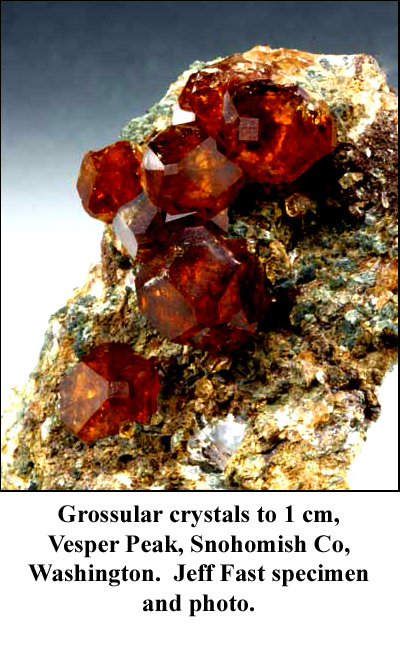
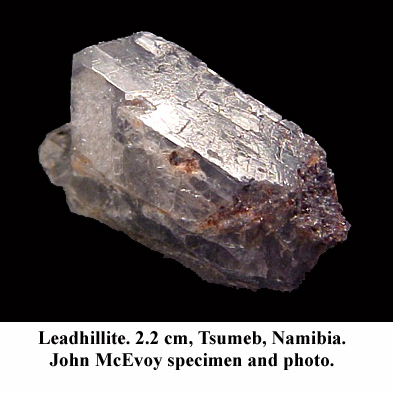 Jason and Mandy McAvory have been selling minerals on e-bay since 2001, but are only now building a mineral-marketing website called Mineralman999 (www.mineralman.com). Although still under construction, the site already has an up-and-running auction section, as well as a “Tsumeb Gallery” featuring many unusual specimens from the former collection of Uli Bahmann (you may recall that the bulk of the Bahmann Tsumeb collection was first marketed by Wayne and Dona Leicht of Kristalle at the 2005 Denver Show). On the Mineralman site you may see, besides fine specimens of the major and standard Tsumeb species, superb representatives of such specialties as beudantite, zincgartrellite, hedyphane, duftite pseudomorphous after tennantite, and, in my opinion the most remarkable of the one-of-a-kinders, a sharp, translucent gray single crystal of leadhillite measuring 1 × 1.7 × 2.2 cm, and costing $400.
Jason and Mandy McAvory have been selling minerals on e-bay since 2001, but are only now building a mineral-marketing website called Mineralman999 (www.mineralman.com). Although still under construction, the site already has an up-and-running auction section, as well as a “Tsumeb Gallery” featuring many unusual specimens from the former collection of Uli Bahmann (you may recall that the bulk of the Bahmann Tsumeb collection was first marketed by Wayne and Dona Leicht of Kristalle at the 2005 Denver Show). On the Mineralman site you may see, besides fine specimens of the major and standard Tsumeb species, superb representatives of such specialties as beudantite, zincgartrellite, hedyphane, duftite pseudomorphous after tennantite, and, in my opinion the most remarkable of the one-of-a-kinders, a sharp, translucent gray single crystal of leadhillite measuring 1 × 1.7 × 2.2 cm, and costing $400.
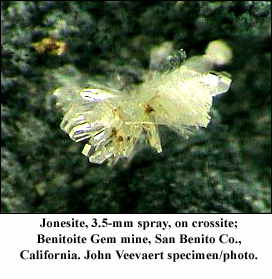 While on the subject of rarities I’ll mention, too, the 13 new specimens of jonesite from the Benitoite Gem mine, San Benito County, California, being offered by John Veevaert on his Trinity Minerals website (www.trinityminerals.com). John, who lives in Weaverville, California, confesses to being a benitoitehead and a devotee of the Benitoite Gem mine, and so is quite proud to show off this rarity-of-rarities from the famous locality, which (according to Bryan Lees, who should know) must now be considered forever extinct. Jonesite, a hydrated silicate of Ba, K, Ti, and Al, occurs in minute sprays of transparent, colorless, wedge-terminated prismatic crystals, and John’s specimens show gleaming and perky-looking microsprays to 3.5 mm (most are considerably smaller) on matrix chunks of blue-gray crossite.
While on the subject of rarities I’ll mention, too, the 13 new specimens of jonesite from the Benitoite Gem mine, San Benito County, California, being offered by John Veevaert on his Trinity Minerals website (www.trinityminerals.com). John, who lives in Weaverville, California, confesses to being a benitoitehead and a devotee of the Benitoite Gem mine, and so is quite proud to show off this rarity-of-rarities from the famous locality, which (according to Bryan Lees, who should know) must now be considered forever extinct. Jonesite, a hydrated silicate of Ba, K, Ti, and Al, occurs in minute sprays of transparent, colorless, wedge-terminated prismatic crystals, and John’s specimens show gleaming and perky-looking microsprays to 3.5 mm (most are considerably smaller) on matrix chunks of blue-gray crossite.
As I’ve said in my print report on the 2006 Munich Show (coming in the March-April 2007 issue), I am most grateful to John Veevaert for filling in for the absent Jeff Scovil by taking specimen pictures for me at Munich. He also helped me in spotting new items to describe, and (as I see now, upon visiting his site) he noticed a few things which I did not notice, and bought them up. From the Czech dealership of KARP he obtained a small lot of miniature-size, loose crystal clusters of brilliant metallic black hematite from Aktas, Kazakhstan. Most of the specimens show some damage, but the beautiful group of platy crystals in parallel growth which is pictured here, measuring 2.5 × 3 × 6.1 cm, is pristine (and is already sold). John had no information concerning the nature of the “Aktas” locality, but at the 2006 Denver Show a Russian dealer had some significant quartz specimens which were said to have come from an outcrop 12 km from “the Aktas mine.” I will try to sleuth after whatever relevant data there may be—any assistance would be welcomed. 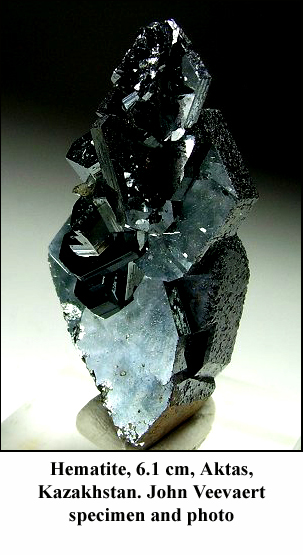
On the extensive website of Wright’s Rock Shop (www.wrightsrockshop.com), Chris Wright has recently posted about 30 old specimens of the bright yellow and yellow-orange “turkey fat” smithsonite that is a characteristic product of the Rush Creek zinc-mining district, Marion County, Arkansas. Smithsonite was the chief ore species in about a dozen significant zinc mines which operated there between 1886 and 1962, and field collecting in the old workings and dumps was generally permitted during the 1960’s and 1970’s, but since the mid-1980’s the area has been off-limits to collectors (for a thorough account of the Rush Creek district, with good photos of “turkey fat” smithsonite specimens, see the article by D.A. Richards in the July-August 1993 issue). The newly posted specimens range from small-miniature to small-cabinet size; in general they are very attractive, showing solid cavity linings of smithsonite, much of it gleaming and wet-looking, most of it yellow (tinted by greenockite), some of it blue, gray-blue or purplish-blue. Mostly from the Philadelphia mine of the Rush Creek district, these specimens come from the collection of Ed Hakesley, an Arkansan who died in 2004. Also, Hakesley had bought the thumbnail collection of Faye Pough (daughter of Fred Pough), and some fine one-of-a-kind thumbnails from this collection are offered on Chris Wright’s site as well.
Already I’m looking forward especially to visiting with Jordi Fabre, who will be in new Tucson quarters this year, in the InnSuites part of the Arizona Mineral & Fossil Show. Indefatigable Jordi always has new and interesting things, these having good odds of being from somewhere in Spain, and just now a pre-Tucson posting of what he calls “express specimens” on his site (www.fabreminerals.com) includes some very fine-looking sphalerite specimens from Mina Las Mánforas, Aliva, Picos de Europa, Cantabria, Spain. Sphalerite from the Aliva district is, of course, “old,” familiar material (see the article by Baranda and Garcia in May-June 1996), but these specimens of Jordi’s, collected, he says, by two local diggers between 1995 and 2002, are most seductive, with sharp, lustrous, honey-colored, totally gemmy sphalerite crystals to about 2 cm on white matrix.
Mike Keim’s Marin Minerals (www.marinmineral.com) offers twelve specimens of—drum roll—Bolivian phosphophyllite, “collected over the past year by a single miner deep in Potosí. These specimens represent the entire find.” Specifically the locality, Mike goes on to say, is the Crauser vein of the Pailaviri mine. In quality the phosphophyllites range from just tolerable to quite good; there are many cleaved crystals and no show-stoppers, but the pale green, mostly gemmy, single and V-twinned crystals reach 1.5 cm. Most are loose, but one specimen is a flat matrix 4.5 cm across bedecked with sharp reddish brown sphalerite crystals surrounding a V-twin of phosphophyllite.
A couple of other interesting things appeared in mid-November on the Marin Minerals site. A famous collecting site called Kilometer 3 in the antique Laurium, Greece mining district has long been known for its world’s-best specimens of bright apple-green annabergite; Kilometer 3 was most prolific during the 1970’s but has never entirely ceased giving up specimens showing brilliant sprays of microcrystals of annabergite (once called “cabrerite”) on splotchy gray, iron oxide-stained matrix. Well, a newly collected group of such specimens is on offer at Marin Minerals: they are miniature through small cabinet-size pieces with little annabergite sprays richly inhabiting vugs all over them.
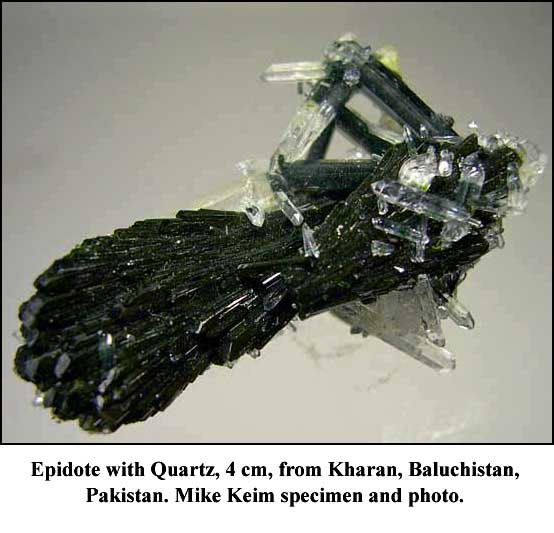 Also, Marin Minerals offers a few specimens from a newly discovered occurrence of epidote with quartz at Kharan, Baluchistan, Pakistan—yes, the so far vaguely defined source of all those new, amazingly fine brookite and anatase specimens you’ve been seeing around. Highly lustrous, typically pistachio-green, fan-sprays of subparallel epidote crystals to 5 cm long are irregularly attached to quartz crystals, the latter ranging from colorless and transparent to milky white; some of the quartz crystals show chloritized phantoms, and many are doubly terminated. If you are thinking that these sound like epidote/quartz specimens resembling those we’re used to seeing from Pampa Blanca, Peru (and not entirely un-reminiscent of some from Prince of Wales Island, Alaska, either), you are correct; check out the picture here.
Also, Marin Minerals offers a few specimens from a newly discovered occurrence of epidote with quartz at Kharan, Baluchistan, Pakistan—yes, the so far vaguely defined source of all those new, amazingly fine brookite and anatase specimens you’ve been seeing around. Highly lustrous, typically pistachio-green, fan-sprays of subparallel epidote crystals to 5 cm long are irregularly attached to quartz crystals, the latter ranging from colorless and transparent to milky white; some of the quartz crystals show chloritized phantoms, and many are doubly terminated. If you are thinking that these sound like epidote/quartz specimens resembling those we’re used to seeing from Pampa Blanca, Peru (and not entirely un-reminiscent of some from Prince of Wales Island, Alaska, either), you are correct; check out the picture here.
Belshazzar’s Gold
The Belshazzar gold mine near Quartzburg, Boise County, Idaho has not been commercially active since the 1930’s, and for an indefinite period before that time it produced good specimens of wire and dendritic gold. In 2004, Idaho collector Allan Young went, with his metal detector, to dig on the old mine dumps, and of the three very good gold specimens that he found he brought the largest to show-and-tell around proudly at the 2004 Denver Show. This wonderful specimen, vindicating all metal-detecting optimists everywhere, is a 10-cm quartz matrix with a deep vug, filling most of the front face, laced densely with lustrous, rich yellow gold wires. Al now sends me word that although he himself struck out on the same dumps in summer 2006 (he had not had his metal detector with him), another collector, checking the turned-over dump material, recovered some fine thumbnail specimens, including the one pictured here: a stout, crystalline wire with other, smaller wires wrapped around it, measuring 2.5 cm long. Unsurprisingly, Allan plans to make another pilgrimage to the Belshazzar mine in summer 2007. 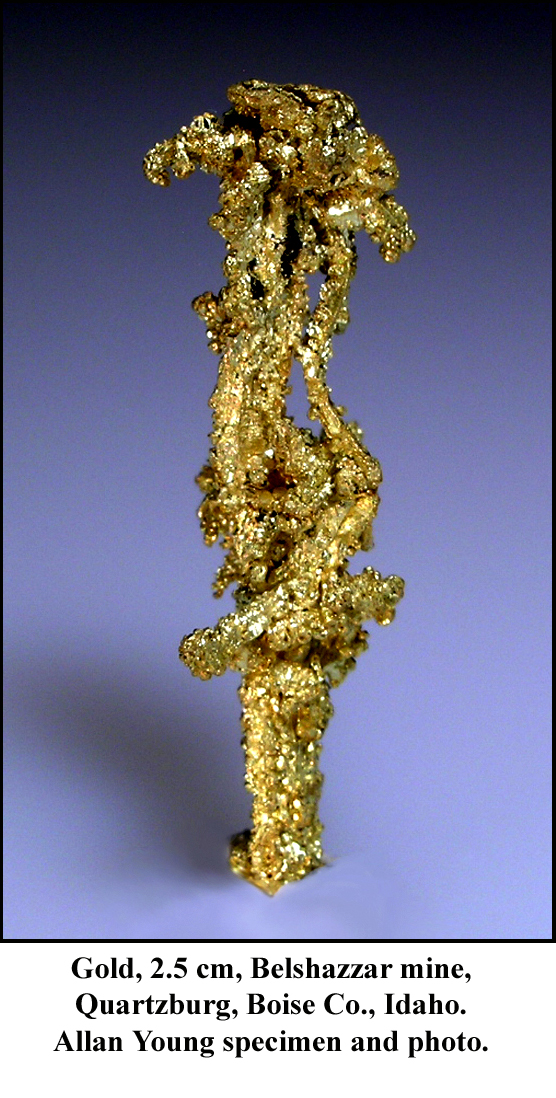
Career Changes
Bill Metropolis, the longtime sidekick of Harvard Mineralogical Museum’s Curator Dr. Carl Francis, has formally announced that he will be retiring from the museum—but not departing the general field of collectibles. He will be embarking on a new career as a dealer in his other passion, numismatics (coin collecting). We wish him a Brilliant Uncirculated success in his new calling.
And to conclude this report I’ll pass on word of an intriguing change in career by longtime mineral dealer Jennings (“Beau”) Gordon of Rome, Georgia, whose 29-year-old dealership is called Jendon Minerals. Beau has appeared, with his kind and helpful demeanor and silky-soft southern accent, at many a major mineral show for most of those 29 years, selling mostly miscellaneous thumbnails of varying qualities but tending emphatically to the superb. At the website address of his dealership (www.jendonminerals.com) you will now find his announcement that as of December 30, 2006 he has discontinued being a show dealer (although, as time allows, he will still do private showings at Tucson, Denver and Munich). Instead, now, he will be devoting himself full time “to the Lay ministry of Jesus Christ,” and you may find word of him at the website thirdstreetministries.org, and you may e-mail him at beau@thirdstreetministries.org. Let us wish Beau well in his religious calling, and (to return forthwith to the secular) let us be mindful of his announcement that “all specimens currently listed on [the Jendon Minerals website], with the exception of thumbnails and ‘cheap stuff,’ are offered at half their listed price.”
Never mind that it’s a foreordained closing line: I will utter it anyway, lustily: SEE YOU AT THE TUCSON SHOW!
For questions about this column, please email Tom Moore.
